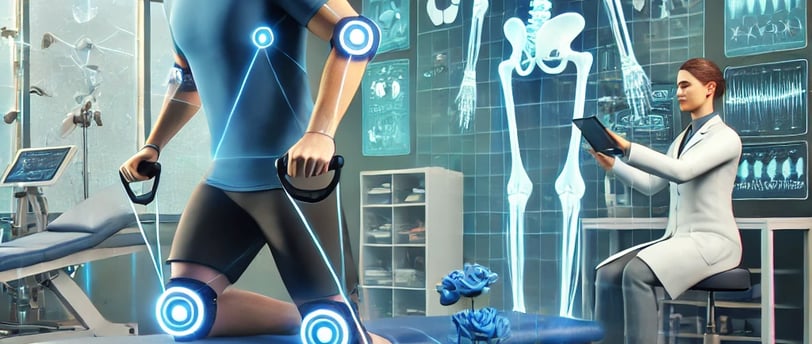MOVEMENT IS MEDICINE, ADD LIFE TO YEARS!
Advancing Physiotherapy: The Role of Virtual and Augmented Reality in Rehabilitation
Physiotherapy has always been at the forefront of innovation, continually evolving to provide better care and faster recovery. One of the most exciting advancements in recent years is the inclusion of Virtual Reality (VR) and Augmented Reality (AR) in physiotherapy. These cutting-edge technologies are revolutionizing rehabilitation by making therapy sessions more engaging, effective, and personalized.
Dr. Akash Roy (PT)
11/25/20243 min read


What Are Virtual Reality and Augmented Reality in Physiotherapy?
Virtual Reality (VR): VR creates a fully immersive digital environment where patients can perform exercises and activities in a simulated, controlled setting. Wearing a VR headset, patients can engage in virtual worlds designed to meet their specific rehabilitation needs.
Augmented Reality (AR): AR overlays digital elements onto the real-world environment using devices like smartphones, tablets, or AR glasses. It helps patients visualize their movements, track progress, or follow on-screen guidance during exercises.
How VR and AR Are Revolutionizing Physiotherapy
1. Enhanced Patient Engagement
Traditional physiotherapy exercises can sometimes feel repetitive, leading to reduced motivation. VR and AR make therapy sessions interactive and enjoyable by introducing gamified tasks and real-world scenarios. Patients may find themselves climbing virtual stairs, catching objects, or walking through a forest, all while performing prescribed exercises.
2. Personalized Rehabilitation
These technologies allow physiotherapists to tailor rehabilitation programs to each patient's needs. For example, VR systems can simulate specific challenges for stroke recovery, such as regaining balance or coordination, while AR can guide patients through exercises with real-time corrections.
3. Real-Time Feedback
AR and VR provide immediate feedback on posture, range of motion, and accuracy of movements. For example, AR systems can show a patient whether their knee alignment is correct during a squat or if they’re achieving the desired range of motion after surgery.
4. Safe and Controlled Environment
Rehabilitation often requires patients to perform activities they may initially fear, such as walking after an injury. VR offers a safe and controlled environment where patients can practice movements without the risk of falling or further injury.
5. Improved Assessment and Monitoring
Advanced sensors and motion-tracking capabilities in AR/VR devices allow physiotherapists to collect precise data on a patient’s progress. This data helps in setting realistic goals, adjusting therapy plans, and providing measurable outcomes.
6. Addressing Neurological Conditions
For patients recovering from conditions like stroke, Parkinson’s disease, or traumatic brain injuries, VR-based exercises can enhance neuroplasticity—the brain’s ability to reorganize itself. For example, a patient can practice reaching for objects in a virtual world to improve motor skills.
Real-World Applications of VR and AR in Physiotherapy
Stroke Rehabilitation: Patients relearn daily activities using virtual environments that simulate real-world tasks, improving motor skills and coordination.
Sports Injury Recovery: VR helps athletes regain strength and balance with sport-specific simulations, such as dribbling a basketball or sprinting.
Chronic Pain Management: VR distracts patients from pain and helps them perform gentle movements, which is especially beneficial for conditions like fibromyalgia or arthritis.
Post-Surgical Rehabilitation: AR guides patients through exercises, ensuring correct techniques and reducing the risk of re-injury.
Benefits of VR and AR in Physiotherapy
Accessibility: With AR apps available on smartphones and VR devices becoming more affordable, these technologies are increasingly accessible.
Cost-Effectiveness: Patients can use AR-based guidance at home, reducing the need for frequent clinic visits.
Motivation: The gamified nature of VR and AR therapy keeps patients motivated to complete their rehabilitation programs.
Challenges and the Road Ahead
While VR and AR are transforming physiotherapy, there are challenges to address:
Cost of Equipment: High-quality VR systems and AR devices can be expensive for clinics and patients.
Training: Physiotherapists need specialized training to integrate these technologies effectively into their practice.
Customization: Creating personalized VR/AR programs for diverse patient needs is still time-intensive.
Despite these challenges, advancements in technology and increasing adoption are paving the way for a future where VR and AR become standard tools in physiotherapy.
Conclusion
Virtual and augmented reality are changing the face of physiotherapy, offering patients an engaging, effective, and innovative way to recover. At Roy Physiocare & Rehabilitation Center, we are exploring these advancements to provide cutting-edge care tailored to our patients’ needs. With the right balance of technology and hands-on expertise, we can help you achieve your rehabilitation goals faster and more effectively than ever before.
Experience the future of physiotherapy—because your recovery deserves nothing less.
Roy Physiocare
Your A to Z Physiotherapy Solution
© 2024 Roy Physiocare. All rights reserved.


/
Call us:
